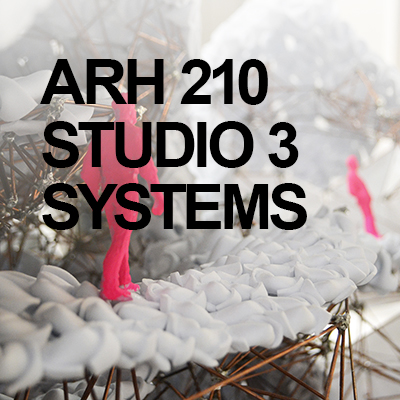
ARH 210 STUDIO 3 SITE OPERATIONS & TECTONIC SYSTEMS
Expand your design process. The catalysts for the examination of your design will come from beyond the architectural norms. You will develop two- and three-dimensional drawings and models based on specific methods of rule-driven design, and learn the behavioral aspects of space and structure.
This course emphasizes collaborative, analytical and parametrically driven design processes, as individually developed generative rule-based techniques. Students research biological systems and establish behavioral logistics of space and structure. They invent strategies to transfer analysis into tectonic prosthetic systems that integrate structure, surface, form, pattern and material organization, in order to create comprehensive architectural buildings. The investigation results into opportunistic and variable spatial circumstances that expose interrelationships between context, process and form. The first project, is a the design of a growth system that parasitically attaches to the body, which establishes the theoretical discourse and architectural language of assembly for the structural system of a potential building.
The methodology of the studio embeds the need for comparative assessment and evaluations of performative processes originating from diverse fields of study, endowed with evolutionary processes that are affected by internal and external conditions. Students investigate behavioral processes, continuously, at various stages of the semester long project. Extensive research and meticulous cataloging of information, establishes design terminology and techniques of structuring future territory as the conceptual grounding of the work.
Students engage critically with sets of performative information originating from fields of study external to architecture and containing evolutionary processes that are affected by internal and external conditions.
Prerequisites: ARH 150, ARH 170, ARH 180
Course Learning Outcomes
- Communicate their design process and apply design skills in their projects
- Demonstrate fundamental design thinking and making skills
- Develop and apply visual communication skills and conceptual skills
- Demonstrate investigative and technical representation and analytical skills
- Conduct and apply research
- Communicate knowledge of cultural diversity
- Show representation of pre-design
- Apply site analysis and site design in their projects
- Demonstrate scale and the relationship of body to building
- Demonstrate programming and circulation
Student Project By: Tatsiana Halavach, Julia Pehoua, Serena Shih, & Rizhao Dong
Student Project By: Jesse Mechling, Daniel Luna, & Christo Camacho
Student Project By: Mai Ho-Nguyen, Boyang Ran, Keano Duran, Danuza Alves Candido Rodrigues
Student Project By: Connor Bowes, Derrick Myat & Anahi Belen Servin Pacua
